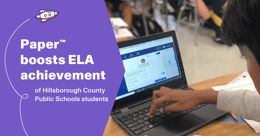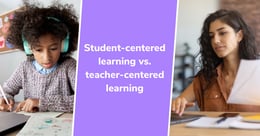
Equity considerations for student-centered learning: An overview
One thing is certain: If we can’t make education equitable, we need to rethink what we’re doing.
For many education leaders, student-centered learning holds immense promise. How can we make sure that this approach is implemented in a way that foregrounds equity? Can it help push such efforts forward? And what is student-centered learning’s place within wider conversations about equity?
Key equity topics when implementing student-centered learning
As the Nellie Mae Education Foundation (NME) refined its mission to focus squarely on equity and student-centered learning in New England, the organization sought to better understand how its existing student-centered framework engaged with important racial equity concerns.
To explore this topic in-depth, NME partnered with two groups—the Coalition of Schools Educating Boys of Color and the Education Development Center—to produce research on racial equity and student-centered learning initiatives.
By conducting interviews and holding focus groups with various school and community stakeholders from areas throughout New England, the report’s authors gathered a rich variety of input.
Among other conclusions noted in the report, researchers observed:
- Study participants largely believed student-centered learning could bolster wider equity efforts in schools, provided the approach contained an unambiguous emphasis on addressing racial equity.
- Efforts to integrate student-centered learning with racial equity objectives should be rooted in a practical, local context, and such initiatives should involve meaningful community engagement.
- Given how rooted they are in their communities—and their flexibility in adopting new practices and approaches—community organizations have the potential to serve as leading sites for hosting equity-based student-centered learning programs.
Zeroing in on collaboration’s place in equitable student-centered learning
As schools attempt to use an equity lens while integrating more student-centered learning practices into the classroom, it’s worth taking note of some of the existing research related to specific practices associated with the approach.
For instance, a study from the American Institutes for Research and the Student-Centered Learning Research Collaborative explored relationships between racial equity, collaborative learning, and personalization.
Personalization, often a key component of student-centered learning initiatives, may be pursued through either individual or collaborative learning activities. Selecting one path over the other may have an impact on equity, and implementation practices play a role too. For their research, the authors of this report studied four different high schools with a particular focus on Black students’ experiences during collaborative learning and how these experiences compared to more individual forms of personalized learning.
Some of the study’s results were quite supportive of the potential held by collaborative learning experiences.
“These findings suggest that for Black students, having the chance to engage in high-quality collaborative activities may help boost academic success,” the study’s authors reported.
However, the researchers also found that, while working in groups, Black students sometimes experienced microaggressions and other forms of exclusion.
“Schools and educators should recognize that Black students may experience collaboration and the classroom environment differently from non-Black students—and should take extra steps to gather feedback directly from Black students to ensure that their collaborative and classroom experiences are positive and reflect desired quality elements,” the researchers advised in their report.
Implementing student-centered learning practices and programs with equity at the core
Once schools and districts are ready to embark on a large-scale journey to elevate student-centered learning opportunities, there are tools they can deploy to ensure the process is centered on equity.
Education Evolving’s comprehensive guide on the subject, “Equity in Student-Centered Learning Design,” is an actionable step-by-step resource for designing, implementing, and continuously improving programs that help all learners succeed.
[READ: “Student-centered learning: What the research says”]
Education Evolving has identified several key principles of student-centered learning, and in the organization’s equity guide, education leaders are encouraged to do the following to mindfully implement student-centered programs and initiatives:
- Undertake individual equity-related research and introspection.
- Work together with team members who are participating in the process to build trust, set guidelines, and establish objectives.
- Review each principle in detail using an equity lens to decide what changes can be implemented immediately to improve the student-centered learning program.
- Commit to more extensive review and ongoing improvement, focusing on one principle where the team can make deeper, lasting changes over the course of a year.
The guide encourages the reader to consider equity-related concerns for each of the group’s established student-centered learning principles.
For example, the final principle in the guide focuses on giving students the opportunity to learn anytime and from anywhere. Readers are asked to consider how learners experiencing homelessness—or those who have to work or care for family members—are affected by the scheduling constraints of a typical school day.
Continuous improvement in using student-centered learning to elevate equity: One school’s journey
In a Students at the Center Hub article about how Winship Elementary School used student-centered learning to advance equity, Mona Ford Walker, former principal of the Massachusetts school, described her team’s five-year effort to better meet student needs.
“As a result of this focus, teacher collaboration grew, student achievement increased, test scores improved, and engagement with families and partners deepened,” said Walker.
The education leader further described how the school had centered equity in its student-centered learning efforts.
As the article notes, “When done right, student-centered learning is an equity move.”
Resources for prioritizing equity in student-centered learning
In addition to the programmatic guidance mentioned previously, it’s clear that discussion, collaboration, and inspiration from high-quality resources can go a long way toward ensuring that student-centered learning is implemented in a way that truly promotes equity.
As such, the Students at the Center Hub also has a free database of resources for equitable student-centered learning. Here, educators can find assistance for concerns related to instruction, classroom culture, family and community engagement, and teacher leadership.
Resources include tailored instructional support for specific subjects, equity considerations based on gender and race or ethnic background, family engagement strategies for multilingual learners, and more.
Achieving equity and centering students
To ensure that student-centered learning is deployed equitably, education leaders need to make a deep, sustained commitment to understanding how to best support all students in the classroom. Much of this work is context-specific and requires continuous refinement as school administrators and teachers engage in ongoing reflection while working directly with community members. Crucially, learning grounded in equity is something that can only be achieved through collaboration and teamwork.
Looking for more information about the impact of activities that promote student-centered learning? Check out our latest ebook, “5 ways student-centered interventions can increase engagement.”






